Field margin management to enhance wild pollinators in agroecosystems
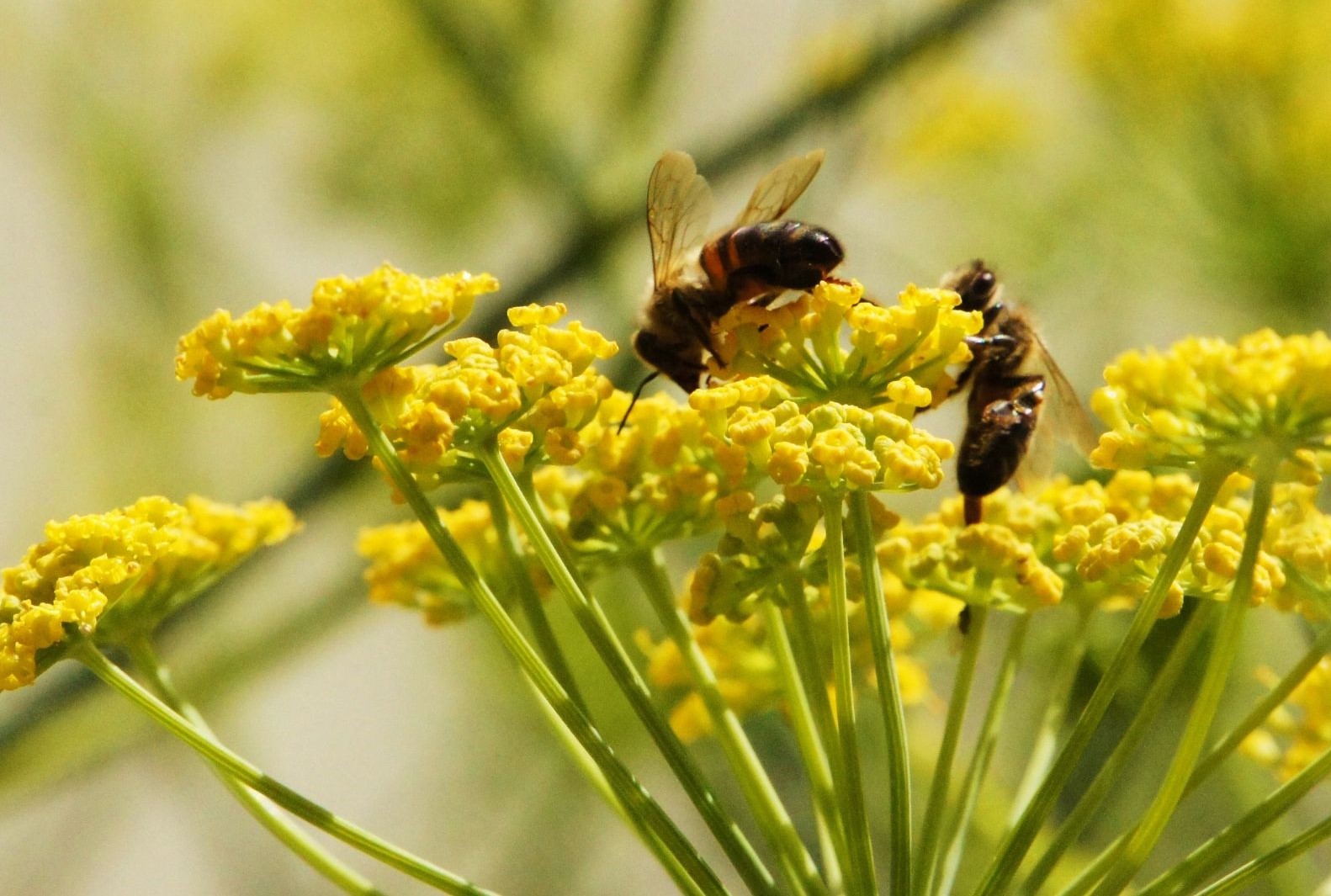
This post is also available in:
This post is also available in:
![]() Español (Spanish)
Español (Spanish)
Field margin management to enhance wild pollinators in agroecosystems: Case studies in Greece
Co-author: Vaya Kati; Aristotle University of Thessaloniki
Why do pollinators and bees matter?
Insects are responsible for pollinating 70% of global crops, and 85% of EU crops’ pollination depends on bees. Beyond agriculture, pollination in 65% of plants necessary for maintaining wild fauna depends on bees. Pollinators are important for the pollination and fruit-setting of various crops. Below, you can find the dependency of various crops on pollinators.

Bees are the most efficient pollinators. We all know the most popular bee, which is the honeybee; there are a lot more wild bees which are very good pollinators. Some examples belong to the groups of bumble bees (Bombus sp.), leaf-cutting bees (Megachilidae), mining bees (Andrenidae), and species of the Halictidae family.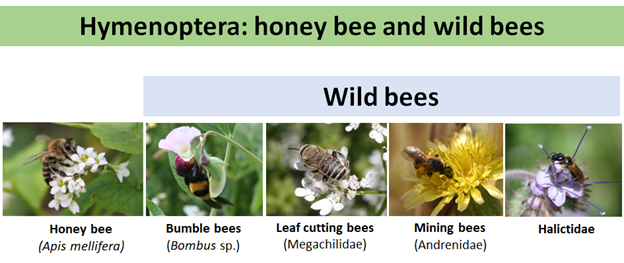
There are 20.000 bee species globally, and 2100 bee species in Europe. The Mediterranean region is one of the most diverse hotspots on a global scale due to the warm and dry weather conditions which favor bees. The map below shows relative bee species diversity: the darker the red color is, the higher the relative species richness for bees.
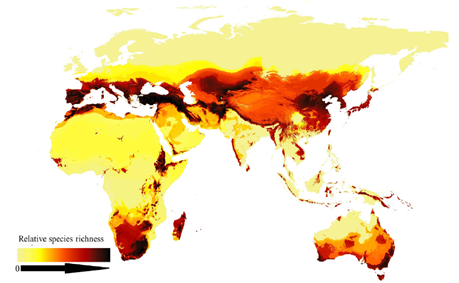
Orr et al. (2021), Current Biology 31: 451–458
Taking into consideration that bees are important for agriculture, we need to appreciate them, and we need to protect them.
Should we worry about bees’ well-being these days?
There are a lot of reports on a global decline in bee species richness, e.g. 25% fewer bees were found between 2006 and 2015 than before 1990 (Zattara and Aizen 2021). There are many factors recognized as threats to bees or causes for this decline: honeybee pests and diseases, habitat loss through urbanization and agriculture, irrational use of pesticides, and climate change.
What does the European Union (EU) do regarding pollinator protection?
In 2018, EU undertook the initiative to reverse the decline of pollinators by 2030 by taking certain measures to conserve wild pollinators in agricultural landscapes both at the farm level and at the landscape level. At the farm level, the measures include enhancement of pollinator-friendly landscape features such as field margins, hedges, fallow land stone walls, open ditches, springs, and solitary trees.
In this context and long before the EU initiative, we raised the question:
Can the establishment of flowering strips in fields attract pollinators in agroecosystems?
The project Operation Pollinator tested the hypothesis that the establishment of flowering strips in the field margins or within the crop, can attract pollinators. It was conducted in several crops and several locations in Greece from 2011 to 2022 and was funded by Syngenta. It included both perennial crops (olive, grapevine, cherry) and annual crops (watermelon, plum tomato, cereals).
We established selected flowering species in mixtures by sowing in field margins (annual, perennial crops) or in patches between rows (in perennial crops).
What were the criteria for selecting these plant species?
- Annual winter species that are not weeds
- Species that had been recorded in the area
- Species that are attractive to pollinators
- Selection of species from several plant families
- Availability and cost of seed
Floral diversity in the mixtures was expected to attract more diverse taxa of pollinators and extend/ prolong the period that floral resources would be available to pollinators by successive flowering of the plant species.
About 35 plant species from 12 families were tested. The most successful cases of plant species in terms of establishment and flowering were coriander, dill, borago, white mustard, rocket, Trifolium spp. Lathyrus spp., lupin and pea. Phacelia and buckwheat were also tested, although they are not native plant species because they are known to be good plants for honeybees.
In these mixtures during flowering, the abundance (number of visits) and diversity of bees from certain groups (honeybees, bumble bees, leaf-cutting bees, megachilids, mining bees, halictid bees) were recorded. Below, are some views of the case studies with the plant mixes in flowering.
In the olive orchard the mixtures were established in patches within the field between the tree rows. Megachilid and Lasioglossum bees on coriander flowers; honeybee and Lasioglossum on white mustard; honeybee on Borago flower. 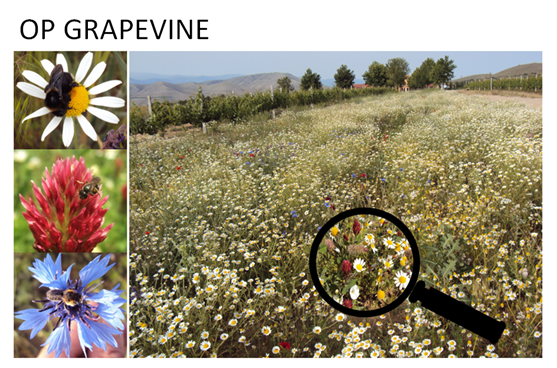
Flowering strip in grapevine: bumble bee on Anthemis sp.; Lasioglossum on Trifolium incarnatum; megachilid bee on Centauria.
Flowering strip in watermelon: left column – honeybees on rocket, white mustard and Glebionis coronaria; right column – Anthophora sp. on rocket; honeybee and halictid bee on phacelia.
Flowering strip in plum tomato: left column – honeybees on grass pea, coriander and Glebionis coronaria flowers; right column-wild bees on coriander, dill, and Sonchus flowers.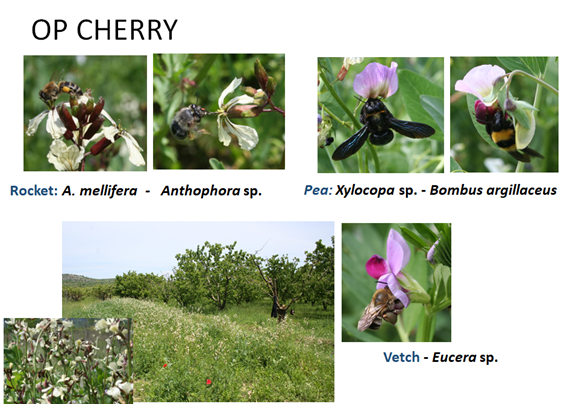
Flowering strip in cherry orchard: honeybee and Anthophora sp. on rocket flowers; Xylocopa sp. and Bombus sp. on grass pea flowers; Eucera sp. on vetch flowers.
Getting back to the original question…
Can the establishment of flowering strips in fields attract pollinators in agroecosystems?
… the answer is yes.
In summary:
- Proper management of weed vegetation and sowing of selected plant species in mixes in field margins or in patches in-field can contribute to the conservation/ enhancement of flower resources for pollinators in agroecosystems.
- Plant species such as coriander (Coriander sativum), dill (Anethum graveolens), borago (Borago officinalis), Glebionis coronaria (crown daisy), rocket (Eruca sativa), white mustard (Sinapis alba), vetch (Vicia sativa), grass vetch (Lathyrus sp.), grass pea (Pisum sativum) have a good establishment and flowers that attract various pollinators.
- A prerequisite when applying these agroecological schemes: Using seeds from local populations. However, the lack of seed houses in Greece to produce the required seed material, led us to use flowering cultivated species such as the ones mentioned above.
References
- https://ec.europa.eu/environment/nature/conservation/species/pollinators/policy_en.htm
- Barda, M., Karamaouna, Kati, V., Perdikis, D. (2022). Do Patches of Flowering Plants Enhance Insect Pollinators in Apple Orchards? Insects, 14(2):208, DOI:10.3390/insects14020208
- Karamaouna, F., Kati, V., Economou, L., Troyanos, G., Samara, M., Liberopoulou, S., M-D Mitroiu and Μ. Edwards (2022) Selected flowering plants as a habitat for pollinators and natural enemies in field margins of a watermelon crop – Implications for crop yield. International Journal of Pest Management, DOI:10.1080/09670874.2022.2055194
- Kati, V., Karamaouna, F., Economou, L., Mylona, P.V., Samara, M., Mitroiu, M-D, Barda, M., Edwards, M. and Liberopoulou, S. (2021) Sown wildflowers enhance habitats of pollinators and beneficial arthropods in a tomato field margin. Plants, 10(5): 1003. DOI: 10.3390/plants10051003
- Karamaouna, F, Kati, V., Volakakis, N., Varikou, K., Garantonakis, N., Economou, L., Birouraki, A., Markellou, E., Liberopoulou, S. and M. Edwards (2019) Ground cover management with mixtures of flowering plants to enhance insect pollinators and natural enemies of pests in olive groves. Agriculture Ecosystems and Environment, 274: 76-89. DOI: 10.1016/j.agee.2019.01.004
- Kati V., Karamaouna F., Kapaxidi E., Mylona P., Economou L., Samara M., Kioleoglou V., Liberopoulou S. Impact of flowering plants in a cereal crop field-margin on pollinators and predatory mites. 18th EWRS Symposium, Ljubljana Slovenia 17-21 June 2018.
- Karamaouna, F., V. Kati, L. Economou, M. Samara (2019). Field margin management to enhance habitats of pollinators and natural enemies in cherry. 18th Panhellenic Congress of Entomology, Komotini, 15-18 October 2019.
- Kati V., Karamaouna F., Volakakis Ν., Varikou Κ., Kapaxidi Ε., Economou L., Garantonakis Ν., Mylona Ph., Samara Μ., Lyberopoulou S., Biruraki Α. (2017). Establishment of selected plants to support pollinators and beneficial arthropods in perennial and annual crops. Proceedings of the 19th Hellenic Weed Science Society, Orestiada, 29-31 March 2017.
- Karamaouna F., V. Kati, Ν. Volakakis, Κ. Varikou, N. Garantonakis, L. Economou, E. Markellou, V. Kalliakaki, F. Andrinopoulos (2011). Effect of groundcover of selected flowering plants on beneficial insects and pollinators in olive and grapevine. Abstracts of the 14th Panhellenic Entomological Congress, Nafplio, 11-14 November 2011, pp. 193-195.
- Orr, M.C., A.C. Hughes, D. Chesters, J. Pickering, C.-D. Zhu and J.S. Ascher (2021). Global Patterns and Drivers of Bee Distribution. Current Biology, 31: 451–458.
- Zattara E.E. and M.A. Aizen (2021). Worldwide occurrence records suggest a global decline in bee species richness. One Earth, 4 (1): 114-123.









































































